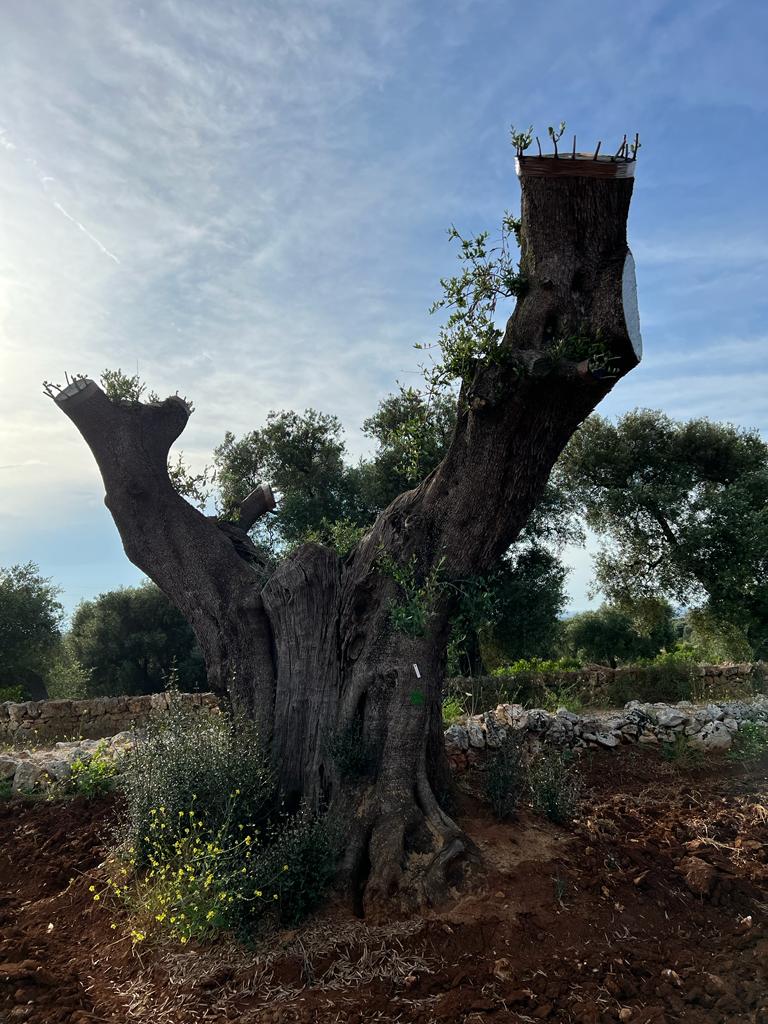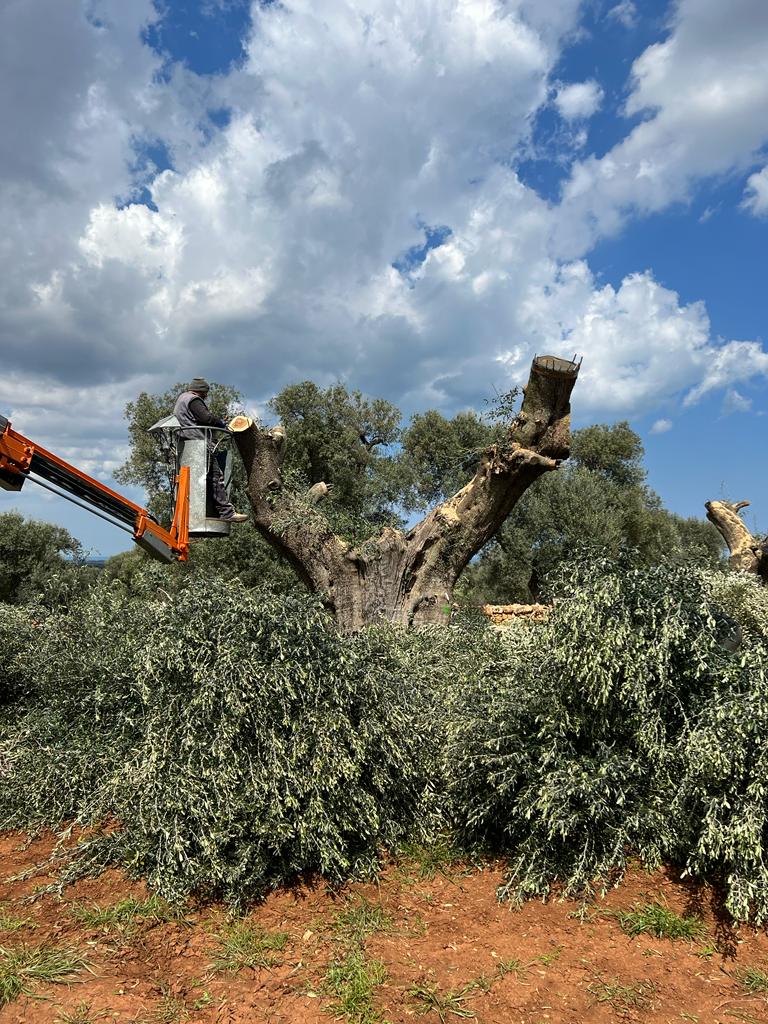Poor harvests due to increasingly warm temperatures, issues of water storage, and plant disease are driving up the market value of olive oil. Long-term answers to the healthy product’s reduced production in Italy and other Mediterranean countries lie in structural policies encompassing climate action.
In Bari, heel of the Italian boot, local newspapers report on police escorts for cargo trucks. Highway patrols take over from the nearest toll booth, followed by a vigilant helicopter, surveying each operation. One could be forgiven for thinking that these events from October 2023 feature a security detail dedicated to transporting diamonds. However, the real treasure being protected was the new green gold – extra virgin olive oil, the basic ingredient we rely on for everyday meals.
Olives and their derivative, central to the Mediterranean Diet, have become particularly appetising for criminal gangs in southern Italy. The opportunists are making illicit profits by pilfering entire harvests from unattended groves or ambushing trucks transporting the precious oil.
Last October, authorities in Andria within the province of Barletta-Andria-Trani, Puglia – well-known for its valuable, high-quality olive oil – had to heighten surveillance measures for mills due to frequent thefts.
And these new security measures are not confined to Italy. Authorities in Spain are grappling with similar challenges: during the same period, approximately 50,000 litres of olive oil, valued at 500,000 euros, were stolen from a mill in Carcabuey, Córdoba (one of the largest olive oil production hubs in Andalusia, Spain). Greek producers have suffered the same issue, with dozens of tonnes of olive oil disappearing in raids on storage facilities.

Photo by ©Save the Olives
Disease, scarcity, and fraud
The value of olive oil skyrocketed in recent years: in September 2023, according to a recent Eurostat survey, prices were 75 per cent higher than those of January 2021. The global upsurge in market value has triggered a wave of fraud, including counterfeit extra-virgin olive oil being sold to high-class restaurants across Italy and Spain. According to Europol, “A mix of various factors, such as the general inflation of prices, reduced olive oil production, and increasing demand, have created the perfect breeding ground for fraudulent producers.”
A decade ago, Xylella Fastidiosa, the bacterium known to block the passage of water and nutrients in plants such as olive trees, reached Puglia, Italy’s largest olive oil-producing region. Since then, it has caused the death of more than 21 million trees across France, Spain, and Portugal, and has been listed by the EU as one of the world’s most crop-threatening pests. In causing a potential annual production loss of 5.5 billion euros, Xylella is still a serious risk to European olive trees. The pathogen and climate change, in combination, are contributing to olive oil becoming a luxury product.

Photo by ©Save the Olives
High temperatures, dry seasons
Extreme weather events rank as high-level environmental threats in the World Economic Forum’s Global Risks Report: they are listed in second position in the short term (2 years) and take the top spot in the long term (10 years). The report anticipates that more frequent and prolonged droughts, as well as abrupt hailstorms, will soon impact the Mediterranean basin.
EU olive oil production plummeted to historic low levels in 2023 due to an extremely hot and dry spring: an almost 40 per cent crop reduction compared to the previous year. A European Food Safety Authority (EFSA) spokesperson does not rule out the prospect of establishing olive production hubs in non-Mediterranean countries: “Many studies have been carried out and published by the scientific community showing, for example, that olive growing may become more difficult in some drier areas and possible in northern regions where winters are becoming less cold.”
It seems such predictions have already materialised: in 2005 two brothers, proprietors of land in Pulheim, Germany, embarked on an ambitious project to plant an olive grove near Cologne. Their plantation boasts around 250 olive trees of different varieties, including Leccino, Cipressino, and Olivastra Seggianese, nestled in the heart of the Rhineland. “Nowhere in Germany are the winters milder than in the Bay of Cologne,” remarks one of the brothers. While not yet utilised for olive oil production, this initiative’s grove offers a glimpse of what may transpire as a common reality in decades to come. Other similar cases are reported in more distant areas of the world such as Canada.
Although EU olive oil production has consistently resembled a sine wave in reports over the past decade, it remains a challenge to imagine a bigger competitor than the Mediterranean on the market for now. Professor Maurizio Servili from Food Science warns, “If you consider that Spain alone contributes to almost forty per cent of global production, extra-Mediterranean producers, de facto, will not be able to compensate.” He sees the problem perpetuating: “The consistency of production within the Mediterranean basin, and in fact eventually outside, is widely questioned, especially considering the last two crop years.”

Chart by © European Commission – Directorate-General for Agriculture and Rural Development
This year, expectations remain subdued: according to the European Commission’s short-term agricultural report, the EU will likely produce only 1.5 million tonnes of olive oil (33 per cent less than the 5-year average). It is estimated that the EU will import 160,000 tonnes from third countries (8 per cent less than the 5-year average). Most imports come from Tunisia, Argentina, and Turkey, but these countries are not immune to the same challenges of Southern Europe: non-EU production in 2023/24 is expected to be 11 per cent less than the 5-year average, with imports from Tunisia decreasing by 35 per cent. Europe is producing less, importing less, and therefore also consuming way less olive oil than before, despite its widely recognised health benefits.
Europe is producing less, importing less, and therefore also consuming way less olive oil than before, despite its widely recognised health benefits.

Photo by ©Save the Olives
Tackling decline
Servili argues that, paradoxically, recent advancements in technology have enabled the production of olive oil with unprecedented quality, surpassing anything seen in the Mediterranean basin and beyond over the past three millennia. “We have a product that has a positive impact on people’s life expectancy and … it has to stay at the centre of the Mediterranean diet. So we should do everything to make that happen,” he says.
The future of olive oil falls on the shoulders of approximately 2.5 million olive producers in the EU (roughly one third of all EU farmers). But as protests continue across Europe and an alarming rate of 800 farmers leave the profession daily, sustainable answers are only to be found in structural policies encompassing climate action.
The olive growers’ consortium Italia Olivicola in Italy reports that half of the country’s groves are in a state of neglect with low resilience against extreme weather events and pests. Given that the average grove spans only two hectares, the group advocates for the inclusion of small and medium-sized olive farmers in discussions with national and regional administrations.
Thirsty olives
“Even though the olive tree is assumed to be resistant to drought, a majority of scientific studies have projected higher net irrigation requirements, yield decrease, and shifting of phenological phases for olive trees in the Mediterranean region due to the increased heat and water stress,” says the International Olive Council (IOC) press office. An earlier harvest season, caused by rising temperatures, reduces the quality of olive oil.
Up until a couple of years ago, farmers in Southern Europe would rely on seasonal rainfall to grow olives. Today, they are taking courses on efficient water use. Rainfall needs to be optimised so that it becomes a resource: significant amounts of water from heavy rainfall, particularly in Italy, are not effectively captured and stored. “We need to make hillside ponds and other water reservoirs. We definitely have to rethink the whole water management and water recovery system, not only nationwide but also for Spain, though better equipped, and Portugal,” adds Professor Servili.
Rainfall needs to be optimised so that it becomes a resource.

Photo by ©Save the Olives
In addition to advocating for enhanced water efficiency, the IOC emphasises the necessity of fostering a sustainable olive oil sector. This entails enhancing soil health with organic matter, decarbonising agronomic operations by using biofuels for vehicles and machinery, using non-synthetic fertilisers, improving the energy efficiency of the process, and using all co-products such as leaves for composting and effluents for irrigation.
Death and new life
Piana degli Ulivi Monumentali, the plain with the highest concentration of supercentenarian olive trees in the entire Mediterranean basin, is one of the areas most highly affected by Xylella in Puglia. Right here, within the vicinity of the towns of Fasano, Ostuni, and Carovigno, local obituaries have announced the death of nine varieties of olive trees affected by the pathogen.

Photo by ©Save the Olives
Save the Olives, a non-profit association in Puglia, is working with the National Research Council (CNR) on several projects to save the monumental olive trees. “We are holding three grafting workshops because we need qualified people for the next campaign in spring,” says Patrizio Ziggiotti, secretary general of the association. “If you graft the tree before it is infected, you can save it.”
Scientific research promoted by EU-funded projects has progressed enormously recently. The CNR’s Institute for Sustainable Plant Protection (IPSP) in Bari has identified two varieties, Leccino and FS 17 (Favolosa), considered resistant to Xylella, authorised for planting in infected areas. “The new varieties are less thirsty, are native, and productive,” says Ziggiotti. “We financed and built a screen-house,” a special greenhouse made of anti-insect netting, “to store them away from any pathogens and parasites, and register them as new varieties.” The battle to save the olives is only just beginning.
